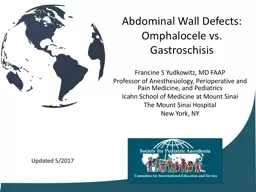

Francine S Yudkowitz MD FAAP Professor of Anesthesiology Perioperative and Pain Medicine and Pediatrics Icahn School of Medicine at Mount Sinai The Mount Sinai Hospital New York NY Updated 52017 ID: 907823
Download The PPT/PDF document "Abdominal Wall Defects: Omphalocele vs. ..." is the property of its rightful owner. Permission is granted to download and print the materials on this web site for personal, non-commercial use only, and to display it on your personal computer provided you do not modify the materials and that you retain all copyright notices contained in the materials. By downloading content from our website, you accept the terms of this agreement.
Slide1
Abdominal Wall Defects:
Omphalocele vs. Gastroschisis
Francine S Yudkowitz, MD FAAPProfessor of Anesthesiology, Perioperative and Pain Medicine, and PediatricsIcahn School of Medicine at Mount SinaiThe Mount Sinai HospitalNew York, NY
Updated 5/2017
Slide2DISCLOSURENo relevant financial relationships
Slide3OBJECTIVESCompare and contrast omphalocele and gastroschisis
Perform an appropriate preoperative evaluationFormulate an anesthetic plan including fluid management and prevention of heat lossIdentify when primary vs. staged closure is performed
Describe the postoperative management
Slide4EMBRYOLOGYGut in yolk sac 5-9 weeks gestation
Gut returns to abdomen 9-11 weeks
Slide5ETIOLOGYOMPHALOCELEFailure of gut to return to the abdomen
Peritoneal sacUmbilical cord attachedGASTROSCHISIS
Vascular abnormalityomphalomesenteric arteryright umbilical veinIschemia in R paraumbilical area allowing for rupture of abdominal wallNo sac
Slide6LOCATIONOMPHALOCELEEpigastricMid-abdominal
HypogastricGASTROSCHISIS
Right lateral to umbilicus
Slide7SIZEOMPHALOCELE< 4 cm (umbilical cord herniation)> 4 cm
> 10 cmGiant omphaloceleLiver may be in sac (30-50%)GASTROSCHISIS
2-5 cmVerticalSmall and large intestineRarely liver
Slide8ABDOMINAL WALL DEFECTSOMPHALOCELE
GASTROSCHISIS
Slide9EPIDEMIOLOGYOMPHALOCELE1:4000-7000Advanced maternal ageFull-term
Congenital anomalies~50%Chromosomal abnormalities~20%13, 15, 18, and 21
GASTROSCHISIS1:3000-8000Young mothers (< 20 y.o.)SmokersPretermLow birth weightGI abnormalitiesmalrotationatresia
volvulus
Slide10OMPHALOCELE:ASSOCIATED ABNORMALITIESApproximately 60% have 1 associated anomalyCVS - Congenital heart disease
GI - Imperforate anus, malrotationGU - Bladder exstrophyCraniofacial - cleft palateChromosomal – 13, 15, 18, and 21
Slide11OMPHALOCELE: SYNDROMEBeckwith-Wiedermann SyndromeOmphaloceleOrganomegalyMacroglossia
Hypoglycemia
Slide12OMPHALOCELE: SYNDROMEPentalogy of CantrellEpigastric omphaloceleSternal cleftAnterior diaphragmatic defectPericardial defect
Cardiac lesion (ASD, VSD, TOF)
Slide13OMPHALOCELE: SYNDROMEOEISOmphaloceleExstrophy of the bladderImperforate anus
Spinal defect
Slide14PREOPERATIVE CONCERNSFluid resuscitationHeat lossSepsisTrauma to intraabdominal organs
Slide15FLUID RESUSCITATIONGastroschisis > omphaloceleLoss of fluid secondary to peritonitis, edema, and third spacingHypovolemia
HemoconcentrationMetabolic acidosisIsotonic fluids (without glucose)10-15 mL/kg/hr (may need 60-120 mL/kg/hr)Adequate resuscitationHeart rate and blood pressure
Capillary refillUrine output (1-2 mL/kg/hr)Monitor electrolytes and acid-base balanceGlucose should be administered in maintenance fluids
Slide16HEAT LOSSLarge surface area exposedRadiant warmerCover defect with non-adherent dressingWarm saline gauze
Quickly loses warmth and may promote cooling if not constantly changedBowel bag
Slide17SEPSISAntibiotic may need to be started
Slide18TRAUMAIncarceration at exit siteCareful not to twist the bowel at the base
Blunt injury to exposed bowelPlace nasogastric tube to decompress the stomach
Slide19TIMING OF SURGERYOMPHALOCELENot emergent/urgentPreoperative evaluation should include identifying:Congenital anomalies
CVS and renalChromosomal abnormalitiesGiant omphaloceleUrgent
GASTROSCHISISEmergent/urgentPreoperative evaluation directed at:Volume statusElectrolyte/Acid-base balance
Slide20INTRAOPERATIVE CONCERNSAirway“Full stomach”Rapid sequence inductionFluid management
D5/D10 at maintenanceIsotonic fluid 10-15 mL/kg/hr (may need much more)Prevent heat lossWarm operating room (270-29
0C)Warming blanketFluid warmerPlace plastic barriers on all sides of the patient
Slide21INTRAOPERATIVE CONCERNSIntravenous accessAdequate peripheral intravenous access for resuscitationConsider central venous catheter
Large defectsRepeated surgeryConsider intraarterial catheterBlood samplingAssociated anomaliesAnesthetic management
No one best anestheticAvoid N2OAdequate muscle relaxation
Slide22PRIMARY CLOSUREPreferred methodNo need to return to the OR for definitive closureAbdominal organs within the abdominal cavity
May result in abdominal compartment syndromeImpairment of respiratory functionDecreased perfusion to intraabdominal organsImpaired venous return to the heart
Increased intracranial pressureWound dehiscence
Slide23STAGED CLOSURECreation of a siloAbdominal organs reduced slowly over days
Slide24PRIMARY vs. STAGEDCriteria for staged repairPeak inspiratory pressure (plateau)
> 25 cm H2OIntragastric pressure> 20 mmHg
Intravesicular pressure> 20 mmHgCentral venous pressure> 4 mmHg above baselineAssociated with decreased cardiac index
Slide25POSTOPERATIVE CONCERNSExtubationSmall defectNo significant associated anomaliesMechanical ventilation until respiratory compliance improves
Monitor for abdominal compartment syndromeContinued edema of the bowel may result in a tight closureParenteral nutrition if delayed bowel function
Slide26LONG TERM OUTCOMESDepends on associated congenital anomalies and chromosomal abnormalitiesParticularly congenital heart diseaseGastrointestinal
Necrotizing enterocolitisShort gut syndromeAdhesionsObstructionTotal parenteral nutrition side effectsLiver injury
SepsisScar complications